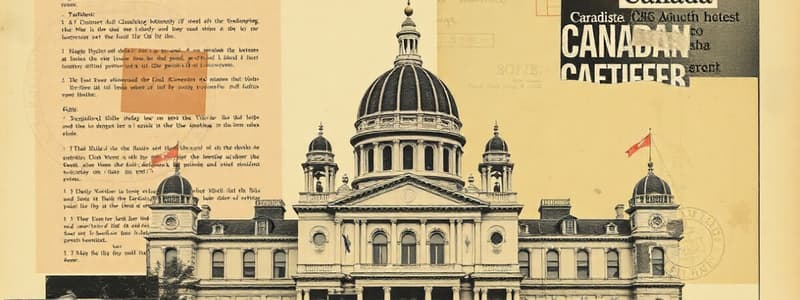Podcast
Questions and Answers
Which branch of the Canadian government is primarily responsible for interpreting laws and ensuring their alignment with the Constitution?
Which branch of the Canadian government is primarily responsible for interpreting laws and ensuring their alignment with the Constitution?
- Legislative Branch
- Administrative Branch
- Executive Branch
- Judicial Branch (correct)
Which of the following is NOT a category of legislation in Canada?
Which of the following is NOT a category of legislation in Canada?
- Municipal Statutes (correct)
- Provincial Statutes
- Federal Statutes
- Constitutionally Entrenched Statutes
Which key constitutional statute granted Canada legislative independence from the United Kingdom?
Which key constitutional statute granted Canada legislative independence from the United Kingdom?
- Constitution Act, 1867
- Canada Act, 1982
- Statute of Westminster, 1931 (correct)
- Constitution Act, 1982
What is typically required to amend the Canadian Constitution, as outlined in Part V of the Constitution Act, 1982?
What is typically required to amend the Canadian Constitution, as outlined in Part V of the Constitution Act, 1982?
Under the Canadian Constitution, which area of responsibility falls under provincial jurisdiction?
Under the Canadian Constitution, which area of responsibility falls under provincial jurisdiction?
What is the 'pith and substance' doctrine used for in Canadian law?
What is the 'pith and substance' doctrine used for in Canadian law?
Which principle is reflected by the separation of legislative, executive, and judicial powers in Canada?
Which principle is reflected by the separation of legislative, executive, and judicial powers in Canada?
When can police officers typically conduct searches without a warrant?
When can police officers typically conduct searches without a warrant?
What right does an individual NOT have upon being detained or arrested?
What right does an individual NOT have upon being detained or arrested?
What is the purpose of the Crown's obligation to provide disclosure to the defense?
What is the purpose of the Crown's obligation to provide disclosure to the defense?
In the Canadian legal system which of the following reflects the balance between effective policing and protecting individual rights.
In the Canadian legal system which of the following reflects the balance between effective policing and protecting individual rights.
In the adversarial system, what is the role of the judge?
In the adversarial system, what is the role of the judge?
What is the primary role of the Crown Attorney (Prosecutor) in a criminal trial?
What is the primary role of the Crown Attorney (Prosecutor) in a criminal trial?
What is the purpose of cross-examination during a trial?
What is the purpose of cross-examination during a trial?
Which type of evidence directly links the accused to the crime (e.g., eyewitness testimony)?
Which type of evidence directly links the accused to the crime (e.g., eyewitness testimony)?
What happens if a jury cannot reach a unanimous verdict?
What happens if a jury cannot reach a unanimous verdict?
What is the purpose of a 'challenge for cause' during jury selection?
What is the purpose of a 'challenge for cause' during jury selection?
What is the purpose of 're-examination' of a witness?
What is the purpose of 're-examination' of a witness?
What is the primary function of the Peace, Order, and Good Government (POGG) clause?
What is the primary function of the Peace, Order, and Good Government (POGG) clause?
Which of the following best describes 'Circumstantial Evidence'?
Which of the following best describes 'Circumstantial Evidence'?
Which of the following is an example of the role of police in criminal investigations?
Which of the following is an example of the role of police in criminal investigations?
What is the purpose of bail hearings in the legal process?
What is the purpose of bail hearings in the legal process?
What does the term 'peremptory challenge' refer to in the context of jury selection?
What does the term 'peremptory challenge' refer to in the context of jury selection?
What instruction does the judge give to the jury before deliberation?
What instruction does the judge give to the jury before deliberation?
What is 'hearsay evidence', and why is it generally inadmissible in court?
What is 'hearsay evidence', and why is it generally inadmissible in court?
Flashcards
Legislative Branch
Legislative Branch
Responsible for creating laws in Canada.
Executive Branch
Executive Branch
Implements and enforces laws in Canada.
Judicial Branch
Judicial Branch
Interprets laws and ensures they align with the Constitution.
Constitutionally Entrenched Statutes
Constitutionally Entrenched Statutes
Signup and view all the flashcards
Federal Statutes
Federal Statutes
Signup and view all the flashcards
Provincial Statutes
Provincial Statutes
Signup and view all the flashcards
Constitution Act, 1867
Constitution Act, 1867
Signup and view all the flashcards
Statute of Westminster, 1931
Statute of Westminster, 1931
Signup and view all the flashcards
Canada Act, 1982
Canada Act, 1982
Signup and view all the flashcards
Constitution Act, 1982
Constitution Act, 1982
Signup and view all the flashcards
Federal Jurisdiction (Section 91)
Federal Jurisdiction (Section 91)
Signup and view all the flashcards
Provincial Jurisdiction (Section 92)
Provincial Jurisdiction (Section 92)
Signup and view all the flashcards
Peace, Order, and Good Government (POGG)
Peace, Order, and Good Government (POGG)
Signup and view all the flashcards
Police Responsibilities
Police Responsibilities
Signup and view all the flashcards
Search and Seizure
Search and Seizure
Signup and view all the flashcards
Charter Protections
Charter Protections
Signup and view all the flashcards
Disclosure
Disclosure
Signup and view all the flashcards
Adversarial System
Adversarial System
Signup and view all the flashcards
Crown Attorney (Prosecutor)
Crown Attorney (Prosecutor)
Signup and view all the flashcards
Defence Counsel
Defence Counsel
Signup and view all the flashcards
Role of the Jury
Role of the Jury
Signup and view all the flashcards
Direct Evidence
Direct Evidence
Signup and view all the flashcards
Circumstantial Evidence
Circumstantial Evidence
Signup and view all the flashcards
Examination-in-Chief
Examination-in-Chief
Signup and view all the flashcards
Cross-Examination
Cross-Examination
Signup and view all the flashcards
Study Notes
- Canada's governance has three branches: legislative, executive, and judicial.
- The separation of powers in Canadian government ensures a system of checks and balances.
Legislative Process and Statutes
- Legislation is the main source of law in Canada.
- Constitutionally Entrenched Statutes are foundational laws that are part of the Constitution and need a rigorous amendment process.
- Federal Statutes are enacted by the Parliament of Canada, and cover areas under federal jurisdiction.
- Provincial Statutes are enacted by provincial legislatures, addressing matters within provincial authority.
- Territorial Statutes are enacted by territorial governments, dealing with regional concerns.
- The legislative process involves introducing a bill, multiple readings and debates, and royal assent.
Key Constitutional Statutes
- The Constitution Act, 1867 established the federal structure and divided powers between federal and provincial governments.
- The Statute of Westminster, 1931 granted Canada legislative independence from the United Kingdom.
- The Canada Act, 1982 patriated the Constitution, allowing Canada full sovereignty over constitutional amendments.
- The Constitution Act, 1982 introduced the Canadian Charter of Rights and Freedoms, ensuring fundamental rights and freedoms.
- Amending the Constitution requires approval from both federal and a significant number of provincial legislatures.
Division of Powers
- The Constitution splits responsibilities between federal and provincial governments.
- Federal jurisdiction (Section 91) includes national defense, immigration, criminal law, and trade.
- Provincial jurisdiction (Section 92) includes education, property rights, and local matters.
- The Peace, Order, and Good Government (POGG) clause allows the federal government to legislate on issues of national concern not explicitly assigned to provinces.
Judicial Interpretation
- Courts interpret laws to ensure they align with constitutional principles.
- Courts assess the "pith and substance" of legislation to determine its true purpose and appropriate jurisdiction.
Role of the Police in Criminal Investigations
- Police officers maintain public order, prevent crimes, and conduct investigations.
- Investigative procedures include collecting evidence, interviewing witnesses, and identifying suspects.
Legal Powers and Limitations of Police
- Police must often obtain a warrant before conducting searches to respect privacy rights.
- Exceptions to the warrant requirement exist under specific circumstances, such as exigent situations.
- Officers can detain individuals for investigative purposes but must have reasonable grounds to proceed with an arrest.
Rights of the Accused
- Individuals have rights upon detention or arrest.
- These rights include being informed of the reasons for the arrest, the right to legal counsel, and protection against self-incrimination.
- These rights aim to prevent abuses of power and ensure a fair legal process.
From Arrest to Trial
- After an arrest, police may lay charges, reviewed by the Crown prosecutor.
- Accused individuals may be released on bail, with or without conditions, pending trial.
- The Crown must provide the defense with all relevant evidence.
Balancing Law Enforcement and Civil Liberties
- It's important to balance effective policing with the protection of individual rights.
The Adversarial System
- Canada employs an adversarial system.
- In this system, the Crown (prosecution) and the defense present their cases before an impartial judge or jury.
- The system ensures justice by allowing both parties to argue their positions, with the judge or jury determining the truth.
Courtroom Participants
- A judge acts as an impartial arbiter, ensuring trial procedures are followed.
- A Crown Attorney (Prosecutor) represents the state, presenting evidence to prove the accused's guilt.
- A Defence Counsel represents the accused, challenging the Crown's evidence and presenting arguments to establish reasonable doubt.
- A Court Clerk manages court records, administers oaths, and handles exhibits.
- A Court Recorder documents verbatim transcripts of the proceedings.
- A Sheriff ensures courtroom security and manages jury selection.
Jury System and Selection
- A jury is a group of 12 citizens tasked with determining the guilt or innocence.
- Potential jurors are randomly selected from the community to form a jury panel.
Challenges
- A challenge of jury list questions the entire jury list if it was improperly compiled.
- A challenge for cause questions specific potential jurors if they cannot be impartial.
- A peremptory challenge allows either party to dismiss a potential juror without providing a reason.
Presentation of Evidence
- Direct evidence directly links the accused to the crime.
- Circumstantial evidence is indirect evidence that suggests the accused's involvement.
- Character evidence involves information about the accused's character.
- Hearsay evidence includes statements made outside of court.
- Opinion Evidence is an expert testimony providing specialized knowledge.
Examination Procedures
- Examination-in-chief (direct examination) is the initial questioning of a witness by the party that called them.
- Cross-examination involves questioning of the witness by the opposing party.
- Re-examination involves further questioning by the original party to clarify issues raised during cross-examination.
Reaching a Verdict
- The judge provides the jury with instructions on the relevant laws.
- The jury discusses in private to reach a unanimous verdict.
- If the jury cannot agree, it may result in a hung jury and potentially a retrial.
- The jury presents its decision in court.
- If the accused is found guilty, sentencing will follow; if found not guilty, the accused is acquitted.
Studying That Suits You
Use AI to generate personalized quizzes and flashcards to suit your learning preferences.




